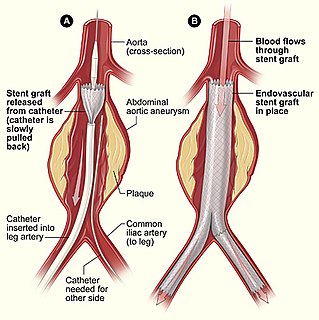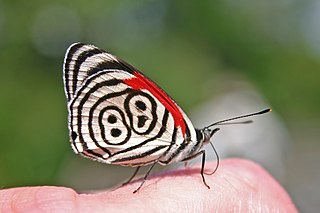Related Research Articles
In Greek mythology, Ceryx was a son of Hermes and either Pandrosus or Agraulus. He was, like his father, a messenger. But the kêryx career began as a humble cook for the tribe, a skill Hermes demonstrates in his cooked meat offerings on the Twelve Gods Altar set in place 522BC by Peisistratos III in Athens. The Homeric Hymn to Hermes 128 recalls the young god cutting out and laying up twelve steaks on a flat rock or platamoni," the 12 Gods altar.

Endovascular aneurysm repair (EVAR), is a type of minimally-invasive endovascular surgery used to treat pathology of the aorta, most commonly an abdominal aortic aneurysm (AAA). When used to treat thoracic aortic disease, the procedure is then specifically termed TEVAR for "thoracic endovascular aortic/aneurysm repair." The procedure involves the placement of an expandable stent graft within the aorta to treat aortic disease without operating directly on the aorta. In 2003, EVAR surpassed open aortic surgery as the most common technique for repair of AAA, and in 2010, EVAR accounted for 78% of all intact AAA repair in the United States.

Ceryx is a genus of moths in the family Erebidae. It was described by Hans Daniel Johan Wallengren in 1863.

Diaethria is a brush-footed butterfly genus found in the Neotropical realm, ranging from Mexico to Paraguay.

Ernest Evar Swanson, was a professional baseball and football player. He played outfielder in the Major Leagues from 1929 to 1934. He would play for the Cincinnati Reds and Chicago White Sox. In the National Football League, he played running back for the Rock Island Independents, Milwaukee Badgers, and Chicago Cardinals from 1924 to 1927. He went to college and played three sports at Lombard College in Galesburg, Illinois.
Similodonta is an extinct genus of early bivalve in the extinct family Praenuculidae. The genus is one of eleven genera in the subfamily Praenuculinae. Similodonta is known from Middle Ordovician through Middle Silurian fossils found in Europe and North America. The genus currently contains eight accepted species, Similodonta ceryx, Similodonta collina, Similodonta djupvikensis, Similodonta magna, Similodonta recurva, Similodonta spjeldnaesi, Similodonta wahli and the type species Similodonta similis.
Ceryx aethalodes is a moth of the subfamily Arctiinae. It was described by Wileman and West in 1928. It is found on the Philippines (Luzon).
Ceryx affinis is a moth of the subfamily Arctiinae. It was described by Rothschild in 1910. It is found in New Guinea.
Ceryx basilewskyi is a moth of the family Erebidae. It was described by Sergius G. Kiriakoff in 1955. It is found in Burundi.
Ceryx calcuni is a moth of the subfamily Arctiinae. It was described by Obraztsov in 1957. It is found on Java.
Ceryx carpentieri is a moth of the subfamily Arctiinae. It was described by Abel Dufrane in 1936. It is found in the Democratic Republic of the Congo.
Ceryx diptera is a moth of the subfamily Arctiinae. It was described by Johan Christian Fabricius in 1775. It is found in southern India and Sri Lanka. In male, the body is black. Frons, collar and tegulae are yellow. Forewings with a sub-basal, two medial, one sub-apical and two sub-marginal hyaline (glass-like) spots. Hindwings with a sub-basal joined to a sub-marginal spot. Tarsi black. Female is similar to male, but differ with the abdomen dilated and with a tuft of ochreous hairs.
Ceryx giloloensis is a moth of the subfamily Arctiinae. It was described by Obraztsov in 1957. It is found on the Maluku Islands of Indonesia.
Ceryx guttulosa is a moth of the subfamily Arctiinae. It was described by Francis Walker in 1864. It is found in Aru, the Key Islands and in Australia, Malaysia and Thailand.
Ceryx helodiaphana is a moth of the subfamily Arctiinae. It was described by Roepke in 1937. It is found on Java.
Ceryx keiensis is a moth of the subfamily Arctiinae. It was described by Rothschild in 1910. It is found on the Key Islands.
Ceryx kuehni is a moth of the subfamily Arctiinae. It was described by Walter Rothschild in 1910. It is found on Taam Island, west of Kai Islands in Indonesia.
Ceryx lamottei is a moth of the subfamily Arctiinae. It was described by Sergius G. Kiriakoff in 1963. It was described from Nimba.
Ceryx riouensis is a moth of the subfamily Arctiinae. It was described by Obraztsov in 1957. It is found on Durian Island in the Riou Archipelago.
Ceryx salutator is a moth of the subfamily Arctiinae. It was described by Sergius G. Kiriakoff in 1965. It is found in the Democratic Republic of the Congo.
References
- ↑ Beccaloni, G.; Scoble, M.; Kitching, I.; Simonsen, T.; Robinson, G.; Pitkin, B.; Hine, A.; Lyal, C., eds. (2003). "Ceryx evar". The Global Lepidoptera Names Index . Natural History Museum . Retrieved April 28, 2018.
| This Ceryx-related article is a stub. You can help Wikipedia by expanding it. |